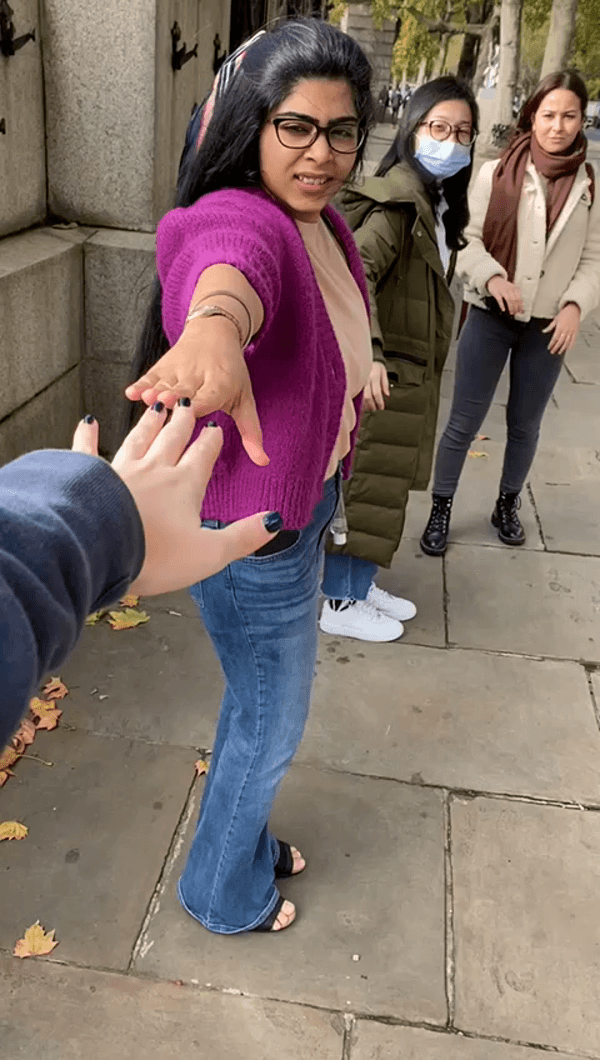22nd October - 25th October
Group B: Tiana Robison, Ziyou Yin (Ines), Sanya Nayar, Kate Chernysheva
How does one communicate using all five senses at once? How does one communicate using none of them at all while at a distance? What other senses are there beyond the five?
These and more questions were racing through my head at the first lecture, which marked the beginning of my journey at LCC (London College of Communications) as an MA User Experience (UX) Design student. Little did I know I had to be able to answer them the next day.
Brief
The brief was very open and invited the students to explore their senses and experiences in London at a given location unique to each group. It challenged the students to try and maintain communication between the group members at distance with and without using 5 basic senses. The goal of the brief was to design an experience of sensing togetherness and replicate that experience in class a week later.
Process
Our exploration journey began at the exact coordinates 51°30’40.8”N 0°06’43.7”W on a Friday morning. The spot was one of the four entrances to the Victoria Embankment Garden, where we carried out most of the investigation and experimentations.
Location: Victoria Embankment Garden. Pictures by Kate.
We started off with remembering the basics taught in class and forming them into a mind map (see mind maps below). Task one required to come up with a combination of the most primary senses possible: sight, hearing, taste, smell and touch. Whereas the second task was the opposite and invited us to think outside the box, or beyond the basic human senses, to come up with a way to stay connected using secondary senses like proprioception, balance, temperature, senses of time and space, etc.
Mind maps to help us brainstorm and keep our ideas in place. Sketches by Kate.
We brainstormed different activities/actions that are perceived through our basic senses, that we could perform at once in order to stay connected. We tried to play around with all of our senses as well as different objects around us in order to achieve that sense of togetherness. We took inspiration from games like Snowball and Chinese whisper and telecommunication methods such as Morse code.
Idea 1: snowball
A sketch to represent the Snowball activity. Sketch made by Kate.
Idea 2: connection through touch


Experiencing togetherness through touch and connecting through our belongings or touch. Photo and video taken by Kate. Sketches made by Kate.
IDEA 3: FLASHLIGHTS



Experiencing connection through using flashlights. We took Morse code as an inspiration and passed on the signal starting from Ines to Tiana to Sanya and then to me. Video taken by Kate. Sketch made by Kate.
IDEA 4: time
Another sense we wanted to experiment with was time. We went around the garden each at a different speed. After completing a circle each of us left a signature sign at an allocated place on the ground. My sign was pressed in leaf, Tiana’s was a shoe pressed dent and etc.


Experiencing togetherness through the sense of time. Photo taken by Kate. Sketch made by Kate.
idea 5: movement


Experiencing togetherness through spelling out words on each other's backs relying on feelings of movement. Video taken by Kate. Sketch made by Kate.
conclusion
To conclude the exploration day we agreed that we managed to experiment quite a lot and had a lot of material to work with to prepare for the presentation on Thursday. We really enjoyed the day where we brainstormed, interacted, shared our ideas and to me it seemed that this is what gave us the sense of togetherness. Especially in times like a global pandemic, feeling the sense of belonging and purpose, working with others is what made us enjoy this day the most. Overall we felt very confident and highlighted the two concepts we liked the most: snowball and flashlights. Other ideas did not give us the same sense of connection even though they were very experimental and creative.
bibliography
Icebreaker Ideas. (2019). The Telephone Game - Icebreaker Ideas. [online] Available at: https://icebreakerideas.com/telephone-game/.
Bradford, A. (2017). The Five (and More) Senses. [online] Live Science. Available at: https://www.livescience.com/60752-human-senses.html.
The Editors of Encyclopedia Britannica (2018). Morse Code | Invention, History, & Systems. In: Encyclopædia Britannica. [online] Available at: https://www.britannica.com/topic/Morse-Code.